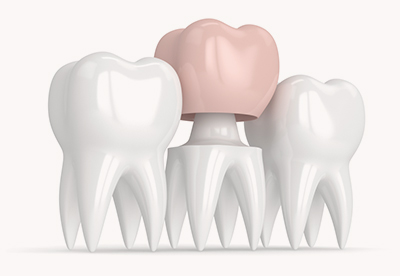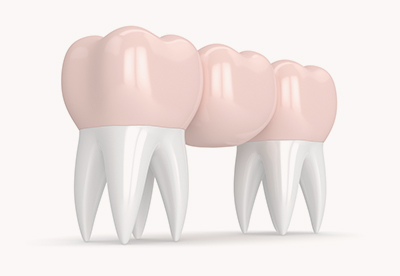![]()
Crowns & Bridgework
A dental crown, or a cap, fits over a decayed, damaged or unattractive tooth, restoring its strength, function and appearance. It can even replace a missing tooth as part of a dental bridge. A crown is the ideal restoration for when a significant amount of a tooth’s structure is missing. This is because, unlike a dental veneer, which covers the front of a tooth and is supported by the tooth’s natural structure, a crown covers the whole tooth to the gum line. At Fryeburg Dental Center, we create lifelike crowns and bridges so you can smile with confidence.
What are Crowns and Bridgework?
As noted, a crown is a covering that goes over the entire visible portion of a tooth. It strengthens the damaged tooth so that it can function normally again. Dr. Harper and Dr. Pickerell can even design the crown to improve upon the tooth’s original appearance.
A bridge typically consists of three crowns and is used to replace a missing tooth. Two crowns are placed on the teeth on either side of the space to support the crown in the middle, called the pontic. A bridge is more convenient, realistic looking and comfortable than a removable prosthesis for replacing missing teeth.
We offer all-porcelain crowns that are indistinguishable from your natural teeth. While porcelain is the most aesthetic option, there are other materials to choose from, including cast gold and porcelain-fused-to-metal (PFM). We’ll discuss the pros and cons of each type with you so you can make the best choice.
Benefits of Crowns and Bridgework
Lifelike and Natural
Our crowns and bridges are lifelike and look completely natural. No one will be able to tell they’re restorations.
Durable
We use cutting-edge materials to ensure your crown or bridge will last for years to come.
Restores Function
Crowns and bridgework strengthen or replace teeth, allowing you to chew, speak and smile confidently.
What to Expect

Getting a Dental Crown
Crowning, or capping, a tooth typically takes two to three visits. At the first visit, we’ll prepare the tooth. We’ll numb the area with local anesthetic and then drill the tooth to give it a uniform shape. If you don’t have enough structure left to support a crown, we may need to build the tooth up with filling material.
Once the tooth is prepared, we’ll take digital impressions for the dental lab. The impressions serve as a guide to create a crown that matches your smile and fits your bite. Once the impressions are done, we’ll attach a temporary crown to protect your tooth until your permanent restoration is ready.
At your next visit, Dr. Harper or Dr. Pickerell will remove your temporary crown. They’ll then attach the permanent crown and make any necessary adjustments for optimal function and aesthetics.

Getting a Dental Bridge
This process of getting a dental bridge is similar to getting a dental crown. However, we will need to prepare the healthy teeth on either side of the missing tooth. These are called the abutment teeth. The abutment teeth will be capped in order to support the pontic, or the crown in the center that replaces the missing tooth. If more than one tooth is missing, we’ll need more crowns to bridge the gap between the abutment teeth. Depending on the number of teeth missing, the location and other factors, additional abutment teeth could be necessary. Dr. Harper and Dr. Pickerell are experts at engineering and designing bridges that are best suited to your unique needs and they’ll tailor their approach to your smile.
Discover a New Dental Experience
Our Fryeburg dentists offer expert, comfortable care for patients of all ages in a beautiful office.

